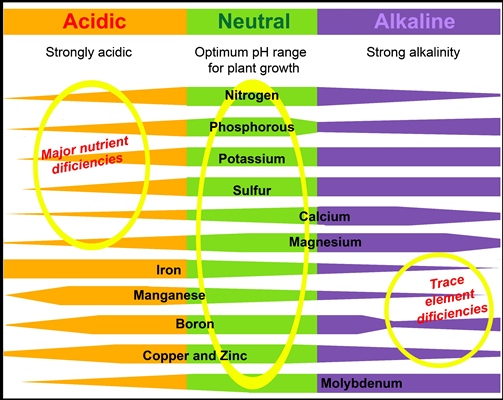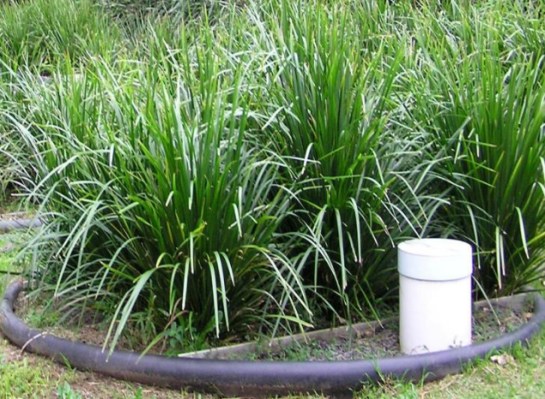Soil pH is tricky to describe in detail and dare I say it …… a little boring! (Apologies here to chemistry buffs.) Before your mind glazes over while I discuss soil pH levels, tests, and treatments ……………….. the single most important thing you need to come away from this article understanding is that soil pH has a dramatic effect on nutrient availability.
We’ll return to this again after a pH ‘crash course’.
What is pH?
pH is the concentration of hydrogen ions in water. The pH scale ranges from 0 to 14, with 7 being neutral. Values below 7 indicate an acid soil, and above 7, alkaline. Because the pH scale is logarithmic, a pH change by 1 unit means it is 10 times more acidic or alkaline(1). The difference between a pH of 7 and a pH of 6 is 10 times the acidity, between 7 and 5 is a 100 times the acidity and so on.
The majority of plants in cultivation grow well in a soil with a pH of 6 to 7.
How do I know if there is a soil pH problem in my garden?
If your plants are growing well and your soil is full of organic matter, worms and other ‘beasties’, it is probably safe to assume all is well and you may never need to worry about soil pH. Even if in this situation, you test the pH and find it outside the range 6 to 7, it is reasonable to assume the plants are obviously coping well with the current soil chemistry and any change may indeed be detrimental.
Indicators of a pH imbalance may include:
• Plants not performing well, even with the addition of fertiliser. Fertiliser added to a soil with a pH imbalance will not be available to the plant;
• ‘Lime-induced chlorosis’ – an iron deficiency caused by high pH levels, seen as yellow-white leaves on plants growing in alkaline soils; or
• flowering hydrangeas (in your own or a neighbours garden). A soil pH of 6 or below will produce blue flowers while a soil pH of 6.8 or higher will produce pink flowers.
The Manutec Soil pH Test Kit is available from retail nurseries and hardware stores and is the most common soil test undertaken by Australian gardeners and farmers. Developed by CSIRO, the Manutec Soil pH Test Kit is arguably not the most accurate test available, however it is economical and instant and will give you a general idea of what’s going on. It is suitable to test soils, compost and potting mixes and involves adding some water to a small soil sample together with chemical indicators. For a short video on how to test soil pH https://www.youtube.com/watch?v=S6AizqoDe5Y
Analysis in a laboratory provides the most accurate measurement of soil pH (2). It used for large scale soil management strategies such as treating acid sulphate soils.
Soil pH and nutrient availability
As already mentioned, the availability of nutrients in soil changes, as pH changes (3). From the attached diagram, it is clear that in the range pH 6 to 7.5 most nutrients are reasonably available to plants. Acid soils with a pH of less than 6 commonly have deficiencies in calcium, magnesium, phosphorus, potassium, molybdenum. Iron, manganese, zinc, copper and boron are commonly unavailable in alkaline soils with a pH of more than 7.
The effect of this nutrient availability on growing plants varies, depending on species. Acid loving plants such as Azalea, Camellia, Gardenia, Blue Hydrangeas and Blueberries prefer an acid soil pH of 5 – 6. Some plants prefer an alkaline soil with Sweet Pea, cacti, Geranium, Hebe, Hibiscus, Ivy Poinsettia and Vibernum growing well in soil pH 7 to 8.
Other effects of soil pH on plant growth
In addition to nutrient availability, the other effects soil pH may have on plant growth include:
• Amounts of nutrients held in soils. Altering soil pH can change the amounts of nutrients that can be held in a soil. As soil pH is raised, more negative charges are produced and these can hold more nutrients as cations.
• Toxicities. Plants can be poisoned in soils of excessively low or high pH. Acid soils with a pH of less than 4 commonly have toxic amounts of aluminium and manganese.
• Microorganisms. All soil microorganisms have a pH range in which they survive and grow best. The trick is to encourage those that are beneficial to plants. Decomposers of organic matter prefer a pH range of 5 to 9. Rhizobium bacteria require pH above 5 (3). This has relevance for many Australian Acacia species relying on rhizobial bacteria to fix nitrogen.
Treating soil pH
Soil pH varies with time, soil moisture and even testing methods. As such, treating soils with a view to keeping pH at exactly 6.5 is not appropriate. Aiming for a pH range or even a general desired ‘trend’ towards acid or alkaline is more realistic.
Raising pH is undertaken with the addition of liming material. Generally garden lime is made up of calcium carbonate. Although it is not pure, it does have significantly less magnesium carbonate than Dolomite. For most applications and particularly where magnesium is already present in the soil in high amounts, garden lime is the best choice. Dolomite is a mixture of calcium and magnesium carbonates and is commonly used in potting mixes where additional magnesium is welcomed.
Lowing pH is a little more tricky, with powdered sulphur the cheapest and most commonly used material.
For details on how much lime or sulphur to add, depending on soil type refer http://soilphtesting.com/?page_id=10
Another option for treating soil pH, is adding organic matter via compost, green manure crop or organic mulch. This buffers the pH, which means that it tends to bring both acid and alkaline soils closer to neutral (4).
Australian Native Plants, Bluedale and Soil pH
Australian soils have a wide variety of pH, some with quite extreme levels. Soils of the Sydney region are renowned for their low pH. On the other side of the continent, in Perth, soils close to the limestone based coastal sands are naturally alkaline and plants indigenous to this area require alkaline conditions to survive.
The majority of the plants grown by Bluedale are native to Australia. Many can cope with pH outside the preferred range of 6 to 7, however it is important to note we generally grow plants for the landscape/garden industry. As such they have been carefully selected, and are proven to grow well in the conditions prevalent in Australian garden conditions – this includes a pH of 6 to 7.
References
(1) Government of Western Australia, 2010. Department of Agriculture and Food Garden Note 174 ‘Soil pH and plant health in the home garden’.
(2) NSW Agriculture (2000) ‘Leaflet No 2. ‘Understanding Soil pH’
(3) Handreck, K.A. and Black,N.D. 1984 ‘Growing Media for Ornamental Plants and Turf’. New South Wales University Press. Printed in Singapore by Kyodo Printing.
(4) Organic Gardening Website http://www.organicgardening.com/learn-and-grow/understanding-ph


![The 'Treatment Train' Process [2]](https://bluedaleplantsonlineblog.wordpress.com/wp-content/uploads/2014/11/pic-from-lismore-use-1st-in-blog.jpg?w=300&h=156)
![Typical Reed Bed showing major components [3]](https://bluedaleplantsonlineblog.wordpress.com/wp-content/uploads/2014/11/pic-from-2005-use-2nd-in-blog.jpg?w=545&h=196)
